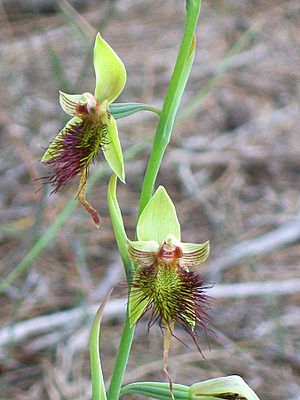Red beard orchid facts for kids
Quick facts for kids Red beard orchid |
|
|---|---|
 |
|
| Calochilus paludosus in Ku-ring-gai Chase National Park, Australia | |
| Scientific classification | |
| Genus: |
Calochilus
|
| Species: |
paludosus
|
The Red beard orchid, also known as the red beardie, is a special type of orchid flower. It grows naturally in Australia and New Zealand. This orchid has a single green leaf and up to nine greenish flowers with reddish stripes. Its most unique part is the "beard" on its labellum (a special petal), which is dull red or coppery. Unlike some other beard orchids, it doesn't have "eye" spots.
Contents
What Does the Red Beard Orchid Look Like?
The Red beard orchid is a plant that grows from the ground. It is a perennial herb, meaning it lives for more than two years. It also loses its leaves in some seasons (it's deciduous). This orchid has an underground tuber, which is like a storage part.
It grows a single, fleshy leaf that is light green to yellowish-green. This leaf is shaped like a long, narrow spear. It can be about 100 to 180 mm (4 to 7 inches) long and 4 to 7 mm (0.16 to 0.28 inches) wide. The leaf is fully grown when the plant flowers.
The orchid can have up to nine greenish flowers with reddish stripes. These flowers grow on a stem that is about 150 to 350 mm (6 to 14 inches) tall.
- The top petal, called the dorsal sepal, is about 11 to 15 mm (0.43 to 0.59 inches) long. It is 6 to 8 mm (0.24 to 0.31 inches) wide.
- The side petals, called lateral sepals, are similar in length but a bit wider.
- The other two petals are 5 to 8 mm (0.20 to 0.31 inches) long and 4 to 5 mm (0.16 to 0.20 inches) wide.
The most interesting part is the labellum. This is a special, flat petal that looks like a tongue. It is about 22 to 28 mm (0.87 to 1.10 inches) long and 7 to 9 mm (0.28 to 0.35 inches) wide. Near its base, it has small, reddish bumps called calli. It also has a flap-like ridge on each outer edge.
The middle part of the labellum has coarse, dull red or coppery hairs. These hairs can be up to 7 mm (0.28 inches) long, giving it a "beard" look. The very tip of the labellum has a hairless "tail." This tail is about 10 to 14 mm (0.39 to 0.55 inches) long and 1 mm (0.04 inches) wide. The central part of the flower, called the column, does not have the "eyes" that many other beard orchids have. This orchid usually flowers from September to January.
How Did It Get Its Name?
The Red beard orchid was first officially described in 1810. A famous botanist named Robert Brown gave it its scientific name, Calochilus paludosus. He published his description in a book called Prodromus Florae Novae Hollandiae.
The second part of its scientific name, paludosus, comes from a Latin word. It means "boggy" or "marshy." This name gives us a clue about where this orchid likes to grow!
Where Does It Grow?
The Red beard orchid is found in many places across eastern Australia. It often grows in areas with low, shrubby plants called heath. It also lives in open forests. You can often find it in wet places, but it can also grow in drier open forests.
In Australia, it is found in:
- Queensland, south from Burleigh Heads.
- Most coastal areas of New South Wales.
- Mostly high rainfall areas of Victoria.
- Tasmania.
- Only one known spot in South Australia.
In New Zealand, C. paludosus grows in the North Island. It is often found near areas with hot springs or geothermal activity. It also grows in the northern part of the South Island.
See also
In Spanish: Calochilus paludosus para niños

